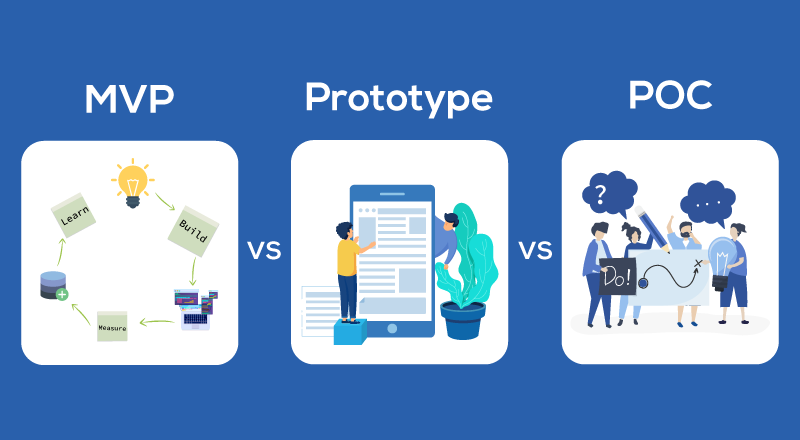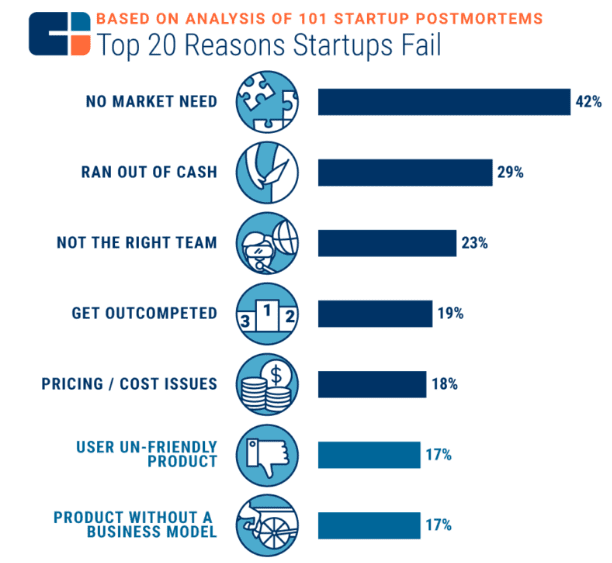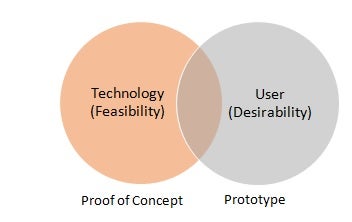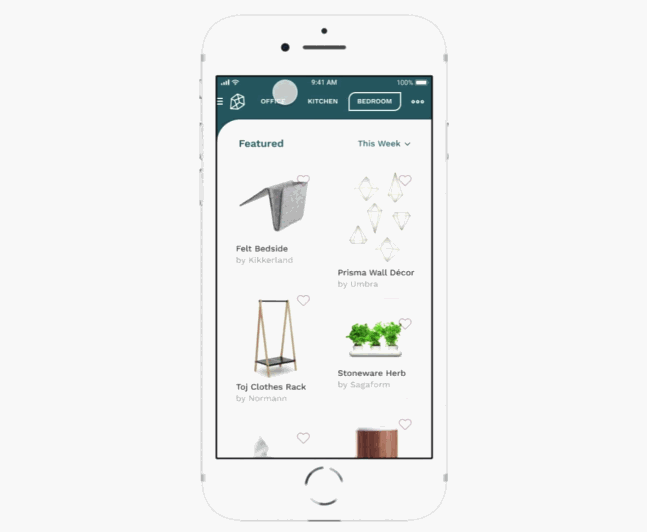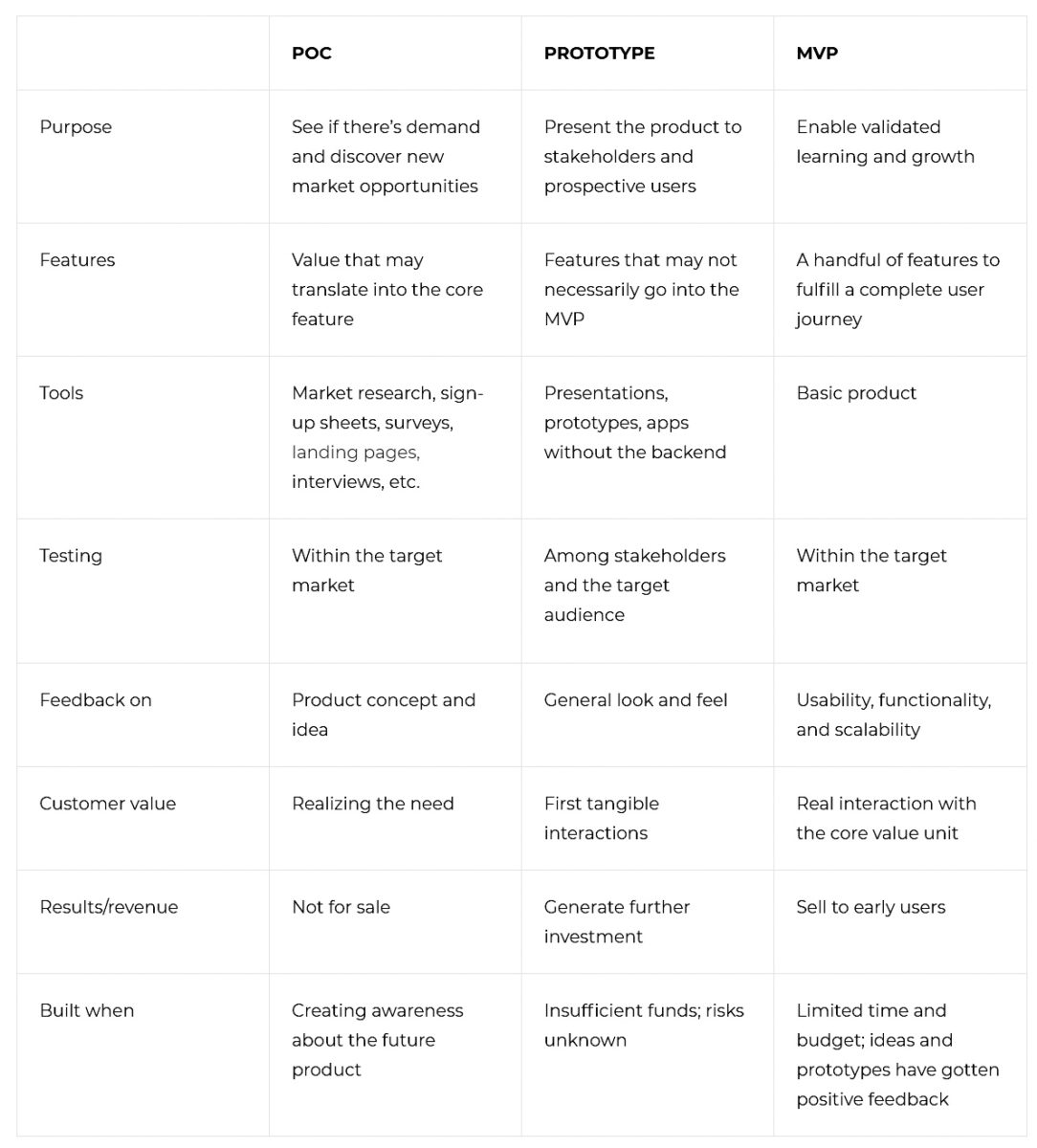Table of Contents
To start a new product is very risky in highly competitive landscapes. It is not only about taking care of the quality and keeping the right price but about the business concept of product/market fit.
According to the definition, the product/market fit is a product that can satisfy the market demand and needs. Going further, we can say that it is an analysis of whether the product will be able to survive in the market, bring some profits, and continue generating revenue.
Basically, estimating a final product can be done in three ways before launching it in the market, namely, MVP (Minimum Viable Product), Prototype, and PoC (Proof of Concept).
Today, we want to give you a 360-degree view of MVPs, POCs, and prototypes, so you can make the right business choices regarding web and mobile apps development. You’ll then be able to attract investors and agencies and see how your product can best bring value to your customers.
The percentage of startups that failed due to the lack of market demand is staggering.
Proof of Concept (PoC)
As you can see by the name, POC is useful in testing out the viability of a product in terms of practical implementation. In our practice, it is more about user testing a flow, not about all products. In this way, we can check if it works as we planned.
Proof of concept is one of the most creative ways to test out if that app idea functions full time. In software development, the proof of concept is able to execute a small-scale project or a fundamental functionality.
This information is closed and it won’t be shown to publicity or customers. It helps in the exploration of whether or not the environments, platforms, or different technologies are suitable for creating a cost-saving solution. After confirmation of the functional or technical feasibility of the project, the product development path starts.
There are several reasons why proof of concept is concerned a viable means of estimating product/market fit:
- POC is a momentary process of testing the potential and viability of the projects;
- It provides a quick “yes” or “no” in relation to the feasibility of a project;
- It’s easy to detect the bugs or errors in the system of the idea during the initial product development stage;
- In the short term the proof of concept will help you to validate whether or not you are moving in a particular direction;
- You will be able to find alternative solutions to the problems, in case the one you are considering seems unfeasible.
Prototype
There are few that understand the difference between POC and prototype. They are usually used as synonyms because the proof of concept is a part of the web or mobile app prototype, roughly speaking.
It is important to define the terminology before starting the app development for everyone to understand what this is about.
The prototype is a part of your product that gives you the opportunity to test a process or concept. A prototype is an interactive mockup of your product, built without a line of code that helps to understand the workflow, along with its usefulness. Also, it responds to taps and imitates how a user inputs data, to give an almost real-life experience of your product.
When we are talking about prototype vs proof of concept, it is not like a separate system, but the prototype provides insights into the user feedback and experience you can expect from your product.
Using prototypes facilitates finding the faults and errors, which affect the flow of an app or impede the user experience.
The usual components of the prototype are user flows, design layouts, mock-ups, and wireframes. There can be designed different kinds of prototypes for testing as a visual prototype, working prototype, functional prototype, and user experience prototype.
It is a great benefit in the evaluation of how trouble-free the user journey can be with your solution. The prototype is a useful way to estimate product or market fit because of:
- the business gets an understanding of all product issues before the start of developing the solution;
- the user experience is one of the main factors to involve customers, and the prototype helps in the estimation of that;
- it is a fast way of testing the acceptance, scalability, and feasibility of a product along with the visual effects;
- there is no need for a lot of investments when it is considered in terms of time, efforts, and finances;
- there is a possibility to get information about the limitations of the system at the initial stage.
Example
Here’s an example of a mobile app prototype built using Figma. Even though the prototype provides user interaction, with no line of code involved in making it.
A PoC, a Prototype, or an MVP (minimum viable product) aren’t different forms of your Product. Actually, only the MVP refers directly to your end-Product.
Minimum Viable Product
The Minimum Viable Product is the first product version that is created for testing the market acceptance of the idea.
In other words, MVP is like the basic model of the product, with the most valuable functions. It gives the opportunity to test only the features of the basic functionality of the software product and adjust the further app development due to the user feedback.
Also, this approach is known as the most effective method of measuring product/market fit because it allows the complete product to enter the market.
As well it helps to understand how the target users perceive a product, the barriers to its performance, and the improvements that can be made for improving the usefulness of the product in terms of UX, UI, and the technical aspects.
After all these aspects get analyzed, the businesses can invest confidently in the future development of a product, think about premium features and services, user feedback, and expect to get a good return on the investment. Read more about Minimum Viable Product here.
Proof of Concept, Prototype, MVP. Differences
You may say that it’s up to you to decide whether to choose for testing the product-market fit as a proof of concept, a prototype, or an MVP.
There might be cases when you will recommend doing at least two of the three before launching the final version of your software product. For better decision-making, here’s an overview of the differences between each.
Remember that all of the named types can help you gain insights about your audience, the tech stack you need, and your business model. That, in turn, will help you save costs and set yourself up for as a successful product maker.
So Which One Do You Need to Build a Successful Product?
You need to consider what kind of product you want to build and what you need to validate before further development starts.
Innovative products should pass full circle, from a POC to a prototype to an MVP. This gradual approach allows you to verify a product idea carefully before committing significant funds to a full development process to release the finished product.
FAQ
Simple business ideas related to mobile app development are being realized by jumping directly into building an MVP and further upgrading and expanding the product. Such a strategy bears a comparatively high risk of failure.
To minimize the risk, an interactive prototype of a product can be built before developing an MVP – send it out for demand estimation and customer evaluation to make a balanced decision about your next steps in the development process.


